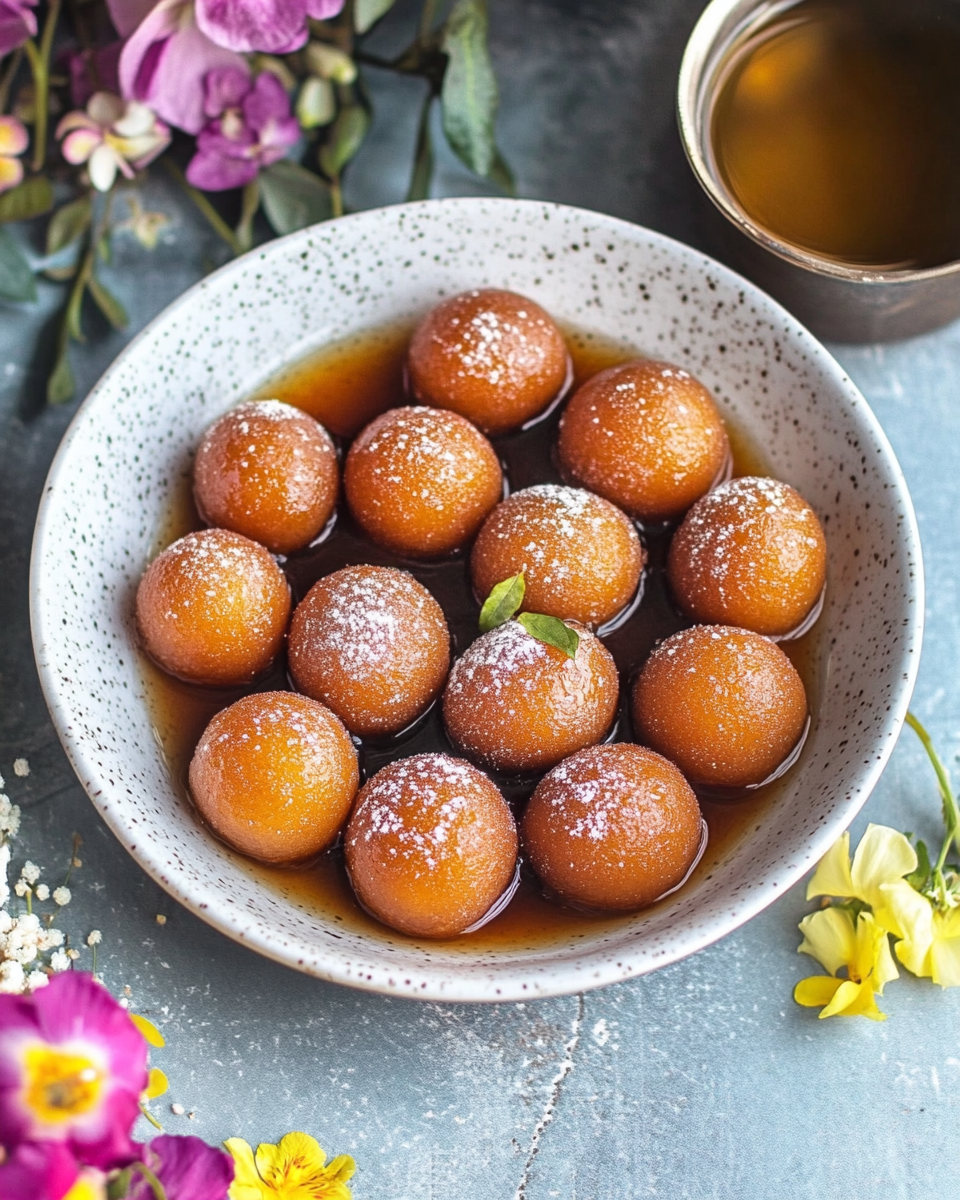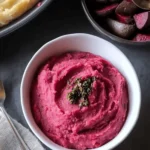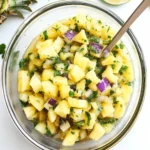A beloved Indian dessert, Juicy Gulab Jamun Balls are soft, deep-fried dough balls soaked in a fragrant rose and cardamom syrup. This decadent treat is perfect for festivals, celebrations, or whenever you crave something irresistibly sweet.
FULL RECIPE
Ingredients
- 1 cup milk powder
- 1/4 cup all-purpose flour
- 1/4 tsp baking soda
- 2 tbsp ghee (clarified butter)
- 1/4 cup milk (adjust as needed for dough consistency)
- Ghee or oil for deep frying
1.For Sugar Syrup:
- 1 1/2 cups sugar
- 1 1/2 cups water
- 4 green cardamom pods, slightly crushed
- 1 tsp rose water (optional)
- A few saffron strands (optional)
Directions
- In a mixing bowl, combine milk powder, all-purpose flour, and baking soda. Mix well.
- Add ghee and rub it into the dry ingredients until it resembles coarse crumbs.
- Gradually add milk and knead gently to form a soft, smooth dough. Do not over-knead.
- Cover the dough and let it rest for 10 minutes.
- Meanwhile, prepare the syrup by combining sugar, water, cardamom, and saffron in a saucepan. Bring to a boil, then simmer for 10 minutes until slightly sticky. Stir in rose water and keep warm.
- Divide the dough into small equal portions and roll into smooth balls, ensuring no cracks.
- Heat ghee/oil on medium-low heat and fry the balls in batches until golden brown. Stir continuously for even coloring.
- Remove from oil and drain excess fat on paper towels.
- Immediately immerse the warm balls in hot sugar syrup. Let them soak for at least 1 hour before serving for maximum juiciness.
Nutritional Information
- Calories: 280
- Carbohydrates: 40g
- Fat: 12g
- Protein: 4g
- Sugar: 28g
- Fiber: <1g
Cultural Significance of Gulab Jamun
Gulab Jamun is more than just a dessert—it’s a cherished part of South Asian culinary tradition. Deeply rooted in Indian, Pakistani, Bangladeshi, and Nepali cultures, it is a symbol of celebration and indulgence. Whether it’s a wedding, religious festival, or special occasion, Gulab Jamun is almost always present. Its rich flavor and melt-in-the-mouth texture make it a crowd favorite across generations.
Traditional Preparation Methods
Historically, Gulab Jamun was made using khoya (milk solids), which required slow-cooking milk over hours to reduce it to a thick paste. This method added depth and richness to the flavor. While modern recipes often use milk powder for convenience, traditionalists still prefer khoya for its authenticity and creamy finish.
Variations Across Regions
Different regions have put their unique spin on Gulab Jamun. In Bengal, for instance, you’ll find Pantua, which is similar but with slight differences in texture and ingredients. In Maharashtra, the dessert may be slightly firmer. Nepalese versions often use paneer or chhena in combination with khoya. Each variation reflects local tastes and traditions.
Serving Styles
Gulab Jamun can be served hot, warm, or cold depending on the season and preference. It is often garnished with chopped pistachios, almonds, or silver leaf (varak) for an elegant presentation. Some people enjoy it paired with vanilla ice cream for a modern fusion dessert that combines warm and cold elements.
Syrup Soaking Technique
The soaking syrup is vital to the recipe. The consistency should be slightly sticky but not too thick, so it seeps properly into the fried dough balls. The syrup must be hot—but not boiling—when the freshly fried balls are added to allow even absorption and ensure a juicy bite in every mouthful.
Common Mistakes to Avoid
One common error is over-kneading the dough, which can make the balls dense or cracked. Another is frying at too high a temperature, leading to uneven cooking. It’s also important not to overcrowd the pan, as this affects oil temperature and can cause the balls to break or remain undercooked.
Making It Vegan-Friendly
A vegan version of Gulab Jamun can be achieved by using plant-based milk, vegan butter, and dairy-free milk powder. While the texture may differ slightly from the traditional version, the result can still be rich and satisfying with the right balance of ingredients and technique.
Gluten-Free Options
For those with gluten sensitivities, alternative flours like rice flour or almond flour can be experimented with. However, adjustments must be made to the dough’s moisture content to maintain the integrity and softness of the balls. Xanthan gum or other gluten replacers can also help hold the structure together.
Pairing with Other Dishes
Gulab Jamun is often served as a standalone dessert but pairs beautifully with other sweets like kheer (rice pudding), rasmalai, or even with Western desserts like cheesecake. In buffet settings, it is commonly accompanied by a scoop of ice cream to balance out the syrupy sweetness.
Shelf Life and Storage Tips
When stored properly in the refrigerator in its syrup, Gulab Jamun can last up to a week. It’s best kept in an airtight container to maintain freshness. Reheat gently before serving, either on the stovetop or in a microwave, ensuring the syrup doesn’t boil, which can change its consistency.
Nutritional Considerations
Gulab Jamun is a calorie-dense dessert rich in sugars and fats. While it’s best enjoyed in moderation, it can be part of a balanced diet if paired with low-fat meals and an active lifestyle. Substituting refined sugar with jaggery or stevia can also reduce the overall sugar content without sacrificing much flavor.
Occasions Best for Gulab Jamun
This dessert is perfect for grand occasions such as Diwali, Eid, weddings, and housewarming ceremonies. It is often included in festive gift boxes and sweet platters due to its luxurious appeal and long-lasting syrup preservation.
Child-Friendly Dessert
Kids are often drawn to Gulab Jamun for its soft, donut-like texture and syrupy sweetness. It is a great way to introduce them to traditional Indian sweets. Ensure the syrup isn’t overly hot before serving to children to prevent burns or discomfort.
Making in Bulk for Events
For large gatherings, Gulab Jamun can be prepared in advance and scaled up easily. It holds well in syrup, making it ideal for party planning. Frying in larger batches requires maintaining consistent oil temperature to ensure each ball is cooked uniformly.
Modern Twists and Innovations
Innovative chefs and home cooks have experimented with chocolate-filled Gulab Jamun, saffron cream-stuffed versions, and even baked alternatives to reduce oil usage. These twists offer a new dimension while retaining the spirit of the original dish.
Role in Indian Cuisine Globally
With the global popularity of Indian cuisine, Gulab Jamun has found its way onto dessert menus in international restaurants. It is often used as an introductory dessert for those new to Indian food and is frequently featured in Indian-themed culinary shows and competitions.
Symbolism in Celebrations
Serving Gulab Jamun during special occasions symbolizes sweetness, prosperity, and joy. It’s commonly part of religious offerings and prasad, given during pujas and temple visits. The round shape also signifies wholeness and unity in some cultural interpretations.
Homemade vs Store-Bought
While ready-made Gulab Jamun is available in cans and mixes, the homemade version is often fresher and more flavorful. The ability to control sweetness, texture, and aroma gives home cooks a distinct advantage, although the store-bought options provide convenience for those short on time.
Tips for Perfect Texture
For soft and juicy balls, the dough must be moist but not sticky. Letting the dough rest allows the ingredients to hydrate properly. Frying at a controlled, medium-low temperature ensures a golden, crisp exterior with a soft and fluffy interior.
Advertisement
Conclusion
Gulab Jamun remains an iconic dessert that transcends borders, traditions, and time. Whether served at a lavish wedding or a simple family dinner, it continues to evoke a sense of celebration, nostalgia, and togetherness. With its rich syrup, delicate aroma, and luxurious texture, Gulab Jamun is not just a dessert—it is a timeless experience.






